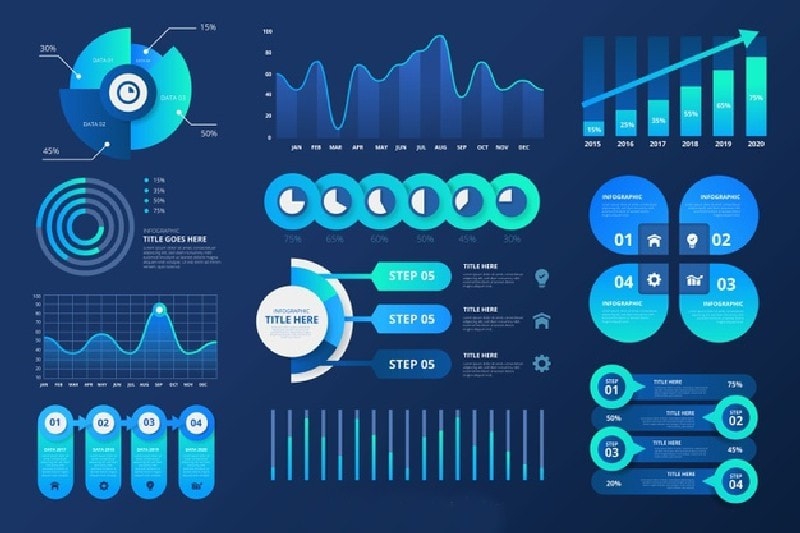Quantitative research is a systematic approach to collect information via sampling methods, for instance, questionnaires, online polls and online surveys. It is gathered from both potential and existing customers and clients and depicted in terms of numerical.
Quantitative research is generally used in fields like political science, gender studies, community health, marketing, sociology, economics, psychology, demography, and education. It’s objective is to employ mathematical theories in relation to phenomena. The process offers a connection between mathematical expression and empirical observation.
Quantitative research is a method to measure variables, analyze them and report relationships amongst the studied variables through a numerical system. Its objective is to understand, analyze, describe and make future predictions of a product or a service because after understanding the numbers, it becomes easier for people to make suitable changes. It deals in objective, logic, and numbers and puts its focus on convergent reasoning and detailed and unchanging data.
The data in quantitative research is collected through structured research, and the results are based on a larger size of samples that represents or reflects the population. An important fact about this kind of research is that it can be repeated and replicated. The questions about the research study are defined, and all its aspects are designed so that the data collected is reliable and accurate.
How can quantitative research be even more impactful?
Quick Statistics: According to a report by Zion Market Research, the global market for data analytics in the quantitative research sector was valued at approximately $26.9 billion in 2020 and is expected to reach around $132.9 billion by 2026, growing at a compound annual growth rate (CAGR) of 31.3% during the forecast period. This surge is driven by the increasing integration of Artificial Intelligence (AI) and Machine Learning (ML) to enhance data accuracy and research outcomes (Source: Zion Market Research, 2021).
Practical Advice: To enhance the effectiveness of your quantitative research, consider integrating digital survey distribution platforms like SurveyMonkey or Qualtrics. These tools not only streamline survey creation and distribution but also offer robust analytics features that allow for real-time data visualization and in-depth analysis. Utilize their advanced features to trigger automatic notifications when significant trends or anomalies are detected, ensuring timely insights and decisions based on your data (Source: Research tool comparison articles, 2022).
The quantitative researcher uses several tools to gather numerical data that is in the form of statistics and numbers and is arranged in non-textual forms like figures, charts, and tables.
Table of Contents
1. Establishes relationships between variables
Quantitative research is considered a traditional sort of scientific method that tries to establish causal relationships and test its strength as well as significance. It has put its onus on objective measurements and numerical, mathematical or statistical data analysis that has been collected over a while through sampling methods or via maneuvering the existing statistical data.
The research is all about making comparisons and determining the relationship between the independent and outcome variable and generalizing the collected data across numerous groups of people. The research design can be either experimental which establishes casualty or descriptive that establishes associations between variables depending upon the situation. The research templates are investigative, and the achieved result is unbiased, statistical and logical.
The importance of quantitative research is that it allows establishing a relationship between variables through a structured method on a sample that is the representation of the entire population.
2. Objective and reliable data collection
Quantitative research is a method used in generating reliable and accurate outcome data by analyzing and measuring them. It can explain why the data is collected and also about its statistical treatment. It also deals with results about relations in the research and reports about the events that were unanticipated during the collection of data.
The research especially explains the reason why both planned and actual analysis differs from each other. It gives a fair idea about handling the data that has gone missing, and why does it not undermine the validity of the research analysis.
The importance of quantitative research is that it helps in objective and reliable collection of data that is discussed in a logical, analytical and comprehensive manner and highlights key findings.
3. Identifying the research problem
The importance of quantitative research is that it is used to investigate research problems. It assists in combining key themes and making viable notes about studies that have been using the same type of analysis and inquiry.
The research also makes viable notes about key gaps that exist in the collected data and how the research study can fill the existing gaps and make suitable clarifications about existing knowledge. Quantitative research is conducted to offer an outline of the theory related to the study to describe the theoretical framework accurately.
It also gives important descriptions about complex or any term that looks unfamiliar, about relevant ideas and concepts and the necessary background information so that the research problem can be placed in an appropriate context. For instance, in a place like economic, cultural or historical.
4. Importance of quantitative research in methodology
Quantitative research offers details about the objectives of the study that is taking place and how will it be achieved so that an informed assessment of the methods to obtain results of the research problem can also be done.
The importance of quantitative research is that it offers tremendous help in studying samples and populations. It discusses in detail relevant questions, for instance, where did the data come from, where are the existing gaps in the data, how robust is it and what were the exclusions within the data research. It is vital to note the process for their selection and describe the methods and tools that are being used by the researcher to collect the information.
The quantitative research identifies variables that are being measured, gives a detailed description of the applicable method that is used in obtaining relevant data, notes down important criteria about the fact that the data was already in existence or the researcher gathered himself.
Remember to mention details and describe what type of instrument was used in the data collection and why, if the researcher was collecting it. Mention any limitations or discrepancies in the methods used for data collection if any. The importance of quantitative research in methodology is that it helps to describe the process or method for both processing and analyzing of data in detail, specific instruments used for studying the research objective and the type of software used in the manipulation of existing data.
In the quantitative method, the findings of the research are written in a precise form that is entirely objective. The non-textual elements like charts, tables and graphs are there that they are used to add to the overall description of the available result. It also clarifies important points so that the reader can understand the data and information in a better manner.
5. Helps in Testing theories
Quantitative research is, in fact, about the cause and also the effect of social phenomena. It starts with an assumption and is used to test hypotheses via its deductive or investigative nature. It tries to minimize a complex problem and then restructure it into limited variables that can be tested easily.
Before starting on its design, it is imperative to decide whether to make the design experimental or descriptive because it will have a direct impact on how the researcher collects, analyzes and interprets the results of the collected data and tests theories. In a descriptive study, the subject of the study is a sample population that can be between hundreds and thousands.
These subjects are measured once, and the purpose of the research is to establish associations between the different variables. The quantitative research ensures that it provides an authenticated estimate of the relationships between variables in a generalized manner. The experimental design, on the other hand, is about a very small and specific sample population chosen with a particular purpose. The subjects are measured before and after the particular treatment to establish casualty between the variables.
The importance of quantitative research is that the researchers can use this research to test hypotheses during the experiment and undertake research on a large-scale basis on the general population. It easily carries out statistical analysis to gather data for accord and is presented in numerical form, for instance, percentages, statistics, etc. The researcher asks the participants through a survey, questionnaire, etc.
specific questions and the answers help him to collect samples. The researcher further analyses the data through the help of statistics. This is done to get an unbiased result that can be used as a generalized version for a larger population.
6. Helps measure customer experience
The importance of quantitative research is that it is easy for it to measure data and show the results via objective data. It provides descriptive data that can be broken down to determine variances between particular groups, for example, age groups. The prediction based on this type of research is via numerical data and is difficult to deny or argue.
One of the significant benefits of opting for quantitative research is its ability to expand the data into predictions and measure customer experience. Commercial business relies heavily on its customers and has tried to put its onus on service-focused operations. For them, the development and measuring of customer service and performance are of utmost importance.
Quantitative research is an important element to obtain a true reflection of the customer experience so that it can make real alterations in performance. The importance of quantitative research in measuring customer experience is immense.
It takes high-volume suitable sample size and finds valid, accurate and trustworthy results in customer insight. It adopts survey-based research so that it can obtain feedback that is in direct relation to population opinions and ideas.
The quantitative research helps in addressing vital parts of the customer journey to discover what the customers think about their experience to make informed business decisions based on this feedback. Another importance of quantitative research is to identify the numerous blockages that are affecting sales performance and restricting service excellence. The research offers a chance to stay connected with customer trends through preferred survey formats which are scheduled regularly to receive instant feedback.
7. Statistical analysis
Quantitative research is a tool that is used to understand and measure the relationship between the independent and dependent variables and generalize a finding. It has an important role to play in product development because of the data collected from this type of research.
For instance, user preference, demographics and market size offers vital information that proves credible during the making of business decisions. Quantitative research aims to count the features, classify them accordingly and develop statistical models.
The research assists in explaining the techniques that are being used by researchers to clean the data set. It chooses a statistical procedure and specifies the computer program that applies to offer a rationale for its reference and use.
Moreover, it is important to offer details about the assumptions in every process and state the steps that ensure there were no violations during the said procedure. Statistical analysis helps to obtain important facts through qualitative research from research data, for instance, differences between demographics and groups and determining preference trends.
It records everything about the data and also about the changes if any that occurs. The importance of quantitative research is that it can provide sample sizes, confidence intervals and descriptive statistics for every variable and the value of the test statistic, its significance level, degrees of freedom and the direction it needs to take.
This will be a great help in avoiding inferring casualty and conveying global effects by integrating graphic representations of confidence intervals.
Liked this post? Check out the complete series on Market research





